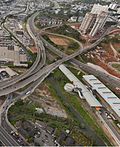Top Qs
Timeline
Chat
Perspective
Salvador Metro
Rapid Transit system in Salvador,Brazil From Wikipedia, the free encyclopedia
Remove ads
The Salvador Metro (Brazilian Portuguese: Metrô de Salvador, commonly called Metrô or Sistema Metropolitano Salvador-Lauro de Freitas) is a rapid transit system serving Salvador city, the state capital of Bahia and the fifth largest city in Brazil. The current system is 38 km (23.6 mi) long and has twenty two stations, which began partial public service on June 11, 2014.[2] The system also has a station at the Salvador Bahia Airport in Lauro de Freitas. It is operated by CCR METRÔ BAHIA Company.
Additionally, Salvador was served by a 14-kilometre (8.7 mi) 1,000 mm (3 ft 3+3⁄8 in) metre gauge railway line known as the Suburban Line (Calçada-Paripe) that does not connect with the Metro. This suburban line will soon become an LRT line integrated to the 38 km (23.6 mi) of the Metro of Salvador.
The construction of the SMSL was carried out in an expansion divided in six stages that integrated the traditional center of the city to Pirajá (and later, in 2023, Campinas and the district of Águas Claras) and to the neighboring municipality of Lauro de Freitas through Line 1 and Line 2 respectively, totaling 38 kilometers and 22 stations.
The Metro connects to other transport systems such as: The Salvador BRT a Bus rapid transit system which shares the Lapa station with the Metro, and the 36.4 km and 34 Station LRT Line which is currently being built to replace the Suburb train and extend it and is predicted to be concluded by 12th of August 2028 and will encounter the Metro at stations in Águas Claras and Bairro da Paz.
Remove ads
Background
Summarize
Perspective

The project is a Build, Operate, and Transfer (BOT) scheme for the operation of the urban rapid rail transportation system in the municipality of Salvador da Bahia, and includes the supply and installation of rolling stock and signaling equipment, and commercial operation of the system for the 25-year concession. Each train, consisting of four cars, has the capacity to carry 1,250 passengers.[3]
Currently, the urban transportation system in Salvador is underdeveloped and largely road-based, causing significant congestion and delays. This level of road-based transport has significant impacts on the local economy and environment. For this reason the municipality and the state, together with the World Bank, have been involved since 1992 in the design and implementation of a transportation strategy. The international standard gauge is 3 kV overhead power supply. And Built by a consortium of Siemens and Camargo Corrêa and Andrade Gutierrez of Brazil.[4]

This project is an integral part of the strategy that aims to improve the quality of public urban transportation in the area by connecting currently excluded low-income neighborhoods, and by furthering the development of a fully integrated urban transportation system.[5]
Salvador Metro system is one of the systems of urban mobility that were deployed for the 2014 FIFA World Cup. The connection of Line 2 with Line 1 of Salvador Metro contributes to connect the International Airport to Downtown Salvador and the Fonte Nova Stadium. The new Line 2 of Salvador Metro integrates the metro stations of the Rótula do Abacaxi and the beach city of Lauro de Freitas in the metropolitan area, passing through the Salvador International Airport, with the Airport metro station.[6]
Remove ads
Operations
Summarize
Perspective
Route

The current route of Line 1 begins at the underground Lapa station, and runs for 1.4 kilometres (0.87 mi) in Metro tunnels, before emerging to the surface. Brotas station (which serves the Itaipava Arena Fonte Nova stadium) is elevated, while Accesso Norte Station and Retiro stations are at-grade.
With Line 1 fully operational over its whole course from Lapa to Campinas as of July 2023[update], it is 13.4-kilometre (8.3 mi) long[7] (with 1.4 kilometres (0.87 mi) underground, 5.8 kilometres (3.6 mi) elevated, with the rest at grade[citation needed]), and serves nine stations.[8]
Stations

The following lists the current, and planned, stations of the Salvador Metro, by their opening date:[9]
Remove ads
Gallery
Network map
See also
References
External links
Wikiwand - on
Seamless Wikipedia browsing. On steroids.
Remove ads














